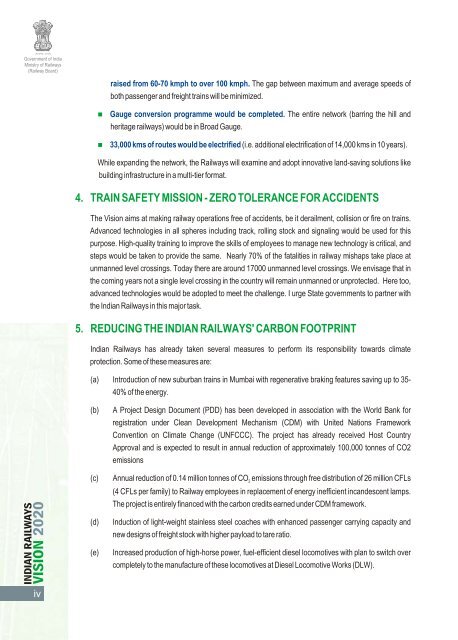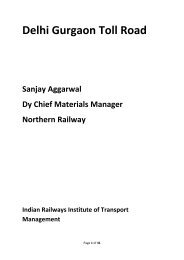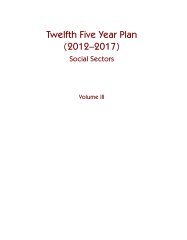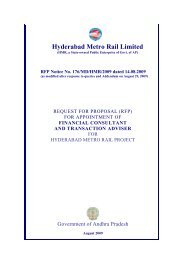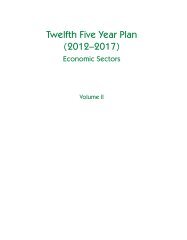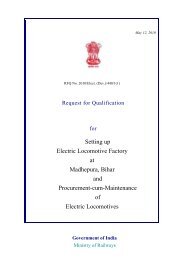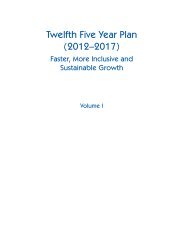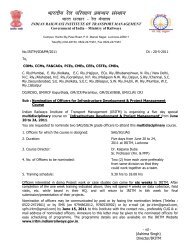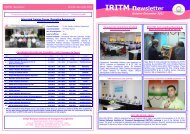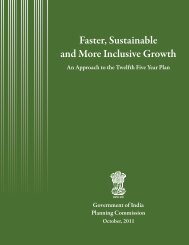Vision 2020 - Transportation Research Group of India
Vision 2020 - Transportation Research Group of India
Vision 2020 - Transportation Research Group of India
Create successful ePaper yourself
Turn your PDF publications into a flip-book with our unique Google optimized e-Paper software.
Government <strong>of</strong> <strong>India</strong><br />
Ministry <strong>of</strong> Railways<br />
(Railway Board)<br />
raised from 60-70 kmph to over 100 kmph. The gap between maximum and average speeds <strong>of</strong><br />
both passenger and freight trains will be minimized.<br />
nGauge conversion programme would be completed. The entire network (barring the hill and<br />
heritage railways) would be in Broad Gauge.<br />
n33,000 kms <strong>of</strong> routes would be electrified (i.e. additional electrification <strong>of</strong> 14,000 kms in 10 years).<br />
While expanding the network, the Railways will examine and adopt innovative land-saving solutions like<br />
building infrastructure in a multi-tier format.<br />
4. TRAIN SAFETY MISSION - ZERO TOLERANCE FOR ACCIDENTS<br />
The <strong>Vision</strong> aims at making railway operations free <strong>of</strong> accidents, be it derailment, collision or fire on trains.<br />
Advanced technologies in all spheres including track, rolling stock and signaling would be used for this<br />
purpose. High-quality training to improve the skills <strong>of</strong> employees to manage new technology is critical, and<br />
steps would be taken to provide the same. Nearly 70% <strong>of</strong> the fatalities in railway mishaps take place at<br />
unmanned level crossings. Today there are around 17000 unmanned level crossings. We envisage that in<br />
the coming years not a single level crossing in the country will remain unmanned or unprotected. Here too,<br />
advanced technologies would be adopted to meet the challenge. I urge State governments to partner with<br />
the <strong>India</strong>n Railways in this major task.<br />
5. REDUCING THE INDIAN RAILWAYS' CARBON FOOTPRINT<br />
<strong>India</strong>n Railways has already taken several measures to perform its responsibility towards climate<br />
protection. Some <strong>of</strong> these measures are:<br />
(a) Introduction <strong>of</strong> new suburban trains in Mumbai with regenerative braking features saving up to 35-<br />
40% <strong>of</strong> the energy.<br />
(b)<br />
(c)<br />
(d)<br />
(e)<br />
A Project Design Document (PDD) has been developed in association with the World Bank for<br />
registration under Clean Development Mechanism (CDM) with United Nations Framework<br />
Convention on Climate Change (UNFCCC). The project has already received Host Country<br />
Approval and is expected to result in annual reduction <strong>of</strong> approximately 100,000 tonnes <strong>of</strong> CO2<br />
emissions<br />
Annual reduction <strong>of</strong> 0.14 million tonnes <strong>of</strong> CO emissions through free distribution <strong>of</strong> 26 million CFLs<br />
2<br />
(4 CFLs per family) to Railway employees in replacement <strong>of</strong> energy inefficient incandescent lamps.<br />
The project is entirely financed with the carbon credits earned under CDM framework.<br />
Induction <strong>of</strong> light-weight stainless steel coaches with enhanced passenger carrying capacity and<br />
new designs <strong>of</strong> freight stock with higher payload to tare ratio.<br />
Increased production <strong>of</strong> high-horse power, fuel-efficient diesel locomotives with plan to switch over<br />
completely to the manufacture <strong>of</strong> these locomotives at Diesel Locomotive Works (DLW).<br />
iv


